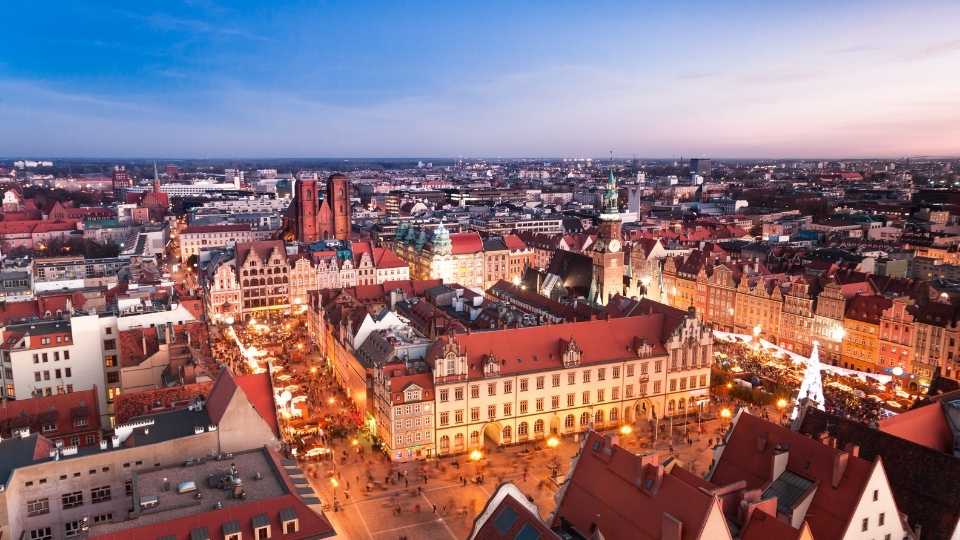Travel Planning
Embracing Green: a Guide to Sustainable Traveling


I know what you’re thinking – sustainable travel sounds great in theory, but is it really possible to make a difference as an individual? The answer is yes!
In this comprehensive guide, I’ll show you how easy it is to reduce your carbon footprint while still enjoying incredible travel experiences.
From eco-friendly travel tips and ethical practices, to green destinations and low impact accommodations, we’ll explore all the ways you can embrace green travel and become a responsible tourist.
So let’s dive in and start making a positive impact on the planet together!
Key Takeaways
- Choose sustainable transportation options like trains or buses instead of flying
- Stay in environmentally friendly accommodations that prioritize energy efficiency and waste reduction
- Engage in ethical wildlife interactions that respect animals’ natural behavior and habitat
- Participate in community-driven tourism initiatives to support local economies and protect the environment
Eco-Friendly Travel Tips: Simple Ways to Reduce Your Carbon Footprint
Here are some easy tips to help you reduce your carbon footprint while traveling.
When it comes to eco-friendly travel, small changes can make a big difference. First, choose sustainable transportation options like trains or buses instead of flying whenever possible. If you do fly, opt for direct flights and pack light to reduce fuel consumption.
While exploring your destination, consider walking or biking instead of using taxis or rental cars. Another important tip is to stay in environmentally friendly accommodations that prioritize energy efficiency and waste reduction.
Finally, be conscious of your daily habits by conserving water, using reusable bottles and bags, and supporting local businesses that promote sustainability.
Principles of Responsible Tourism: Ethical Practices for a Sustainable Travel Experience
When it comes to responsible tourism, there are three key points that we should focus on.
First, ethical wildlife interactions means engaging with animals in a way that respects their natural behavior and habitat, avoiding activities that harm or exploit them.
Second, community-driven tourism initiatives involve working closely with local communities to create sustainable economic opportunities and empower them to protect their environment.
Lastly, minimizing our environmental footprint means taking steps to reduce waste, conserve resources, and choose eco-friendly options throughout our travels.
Ethical Wildlife Interactions
To ensure ethical wildlife interactions, it’s important to remember that respecting animals’ natural habitats and behavior is key. As someone who desires freedom and appreciates the beauty of nature, I understand the importance of treating wildlife with care and consideration.
Here are some guidelines for ethical wildlife interactions:
-
Observe from a distance:
-
Use binoculars or zoom lenses to get a closer look without disturbing the animals.
-
Maintain a safe distance to avoid causing stress or altering their behavior.
-
Do not feed or touch the animals:
-
Feeding wildlife can disrupt their natural diet and lead to dependency on humans.
-
Touching them can transmit diseases and cause unnecessary stress.
By following these practices, we can preserve the well-being of wildlife while still enjoying their presence in their natural habitats.
Let’s be responsible travelers who prioritize animal welfare and contribute to a sustainable future for all species.
Community-Driven Tourism Initiatives
By actively participating in community-driven tourism initiatives, you can directly contribute to the local economy and support sustainable development in the area. When you engage with these initiatives, such as visiting local markets or staying at locally owned accommodations, your travel dollars go directly into the hands of the community members who need it most. This allows them to invest in their businesses, education, and infrastructure, creating a positive cycle of economic growth.
Moreover, by choosing these initiatives over large corporations or international chains, you are helping to preserve the unique cultural heritage of the destination and promoting social equity within the community.
So next time you plan a trip, consider supporting community-driven tourism initiatives for a more meaningful and impactful experience.
To further minimize your environmental footprint during your travels…
Minimizing Environmental Footprint
One way you can minimize your environmental footprint during your travels is by conserving water and energy in your accommodations. By implementing small changes, we can make a big difference in preserving our planet for generations to come.
Here are some simple tips to help you be more eco-friendly while staying in hotels or rental properties:
-
Conserve Water:
-
Take shorter showers.
-
Reuse towels instead of requesting new ones daily.
-
Save Energy:
-
Turn off lights and unplug electronics when not in use.
-
Adjust the thermostat to a reasonable temperature.
These practices not only reduce our impact on the environment but also save money. Let’s embrace a sustainable mindset and make every journey an opportunity to protect our beautiful planet.
Together, we can create a greener future full of freedom and harmony with nature.
Green Travel Destinations: Exploring Nature’s Beauty While Preserving the Environment
Discover breathtaking green travel destinations where you can immerse yourself in nature’s beauty while leaving a positive impact on the environment.
As an avid traveler who values freedom and the preservation of our planet, I am excited to share with you some of the most awe-inspiring places that prioritize sustainability.
From the lush rainforests of Costa Rica to the pristine beaches of Seychelles, these destinations offer a unique opportunity to connect with nature while supporting local conservation efforts.
Whether it’s exploring wildlife reserves or participating in eco-friendly activities, each experience will leave you with memories that will last a lifetime.
So pack your bags and embark on an adventure that not only satisfies your wanderlust but also contributes to the protection and conservation of our Earth.
Let’s explore these green havens together!
Low Impact Accommodations: Finding Eco-Friendly Places to Stay on Your Travels
Looking for environmentally-friendly places to stay while traveling? As a conscious traveler who values sustainability, I understand the importance of finding low impact accommodations that align with our eco-friendly principles. Here are some options to consider:
-
Eco-Lodges: These nature-inspired retreats offer a unique experience, allowing you to immerse yourself in the surrounding environment while minimizing your carbon footprint. Features such as renewable energy sources and water conservation practices are prioritized in eco-lodges, ensuring sustainable living without compromising comfort. By choosing eco-lodges, you support local communities and contribute to the preservation of natural habitats.
-
Green Hotels: Many hotels now embrace sustainability by implementing green practices throughout their operations. Look for hotels with energy-efficient systems, waste reduction programs, and organic food options. Some even have LEED certifications! Staying at green hotels not only reduces your environmental impact but also encourages other establishments to adopt sustainable practices.
Comprehensive Strategies for Carbon-Neutral Travel: Offsetting Your Emissions and Going Green
When it comes to offsetting your emissions and going green while traveling, there are several comprehensive strategies you can implement.
One effective way is to calculate your carbon footprint and then purchase carbon offsets. These offsets fund projects that reduce greenhouse gas emissions and help counterbalance the impact of your travel.
Another strategy is to choose eco-friendly transportation options like trains or electric vehicles whenever possible.
Additionally, you can support local sustainable initiatives by staying in eco-friendly accommodations, eating at organic restaurants, and participating in responsible tourism activities.
It’s important to be mindful of energy consumption by conserving water, using renewable energy sources, and minimizing waste.
Sustainable Travel Resources: Websites, Apps, and Organizations for Eco-Conscious Adventurers
If you’re planning an eco-conscious adventure, there are numerous websites, apps, and organizations available to provide valuable resources for sustainable travel. Here are some of my favorite platforms that can help you make responsible choices while exploring the world:
-
Websites:
-
Sustainable Travel International: Offers tips on eco-friendly destinations and accommodations.
-
Responsible Travel: Provides a wide range of sustainable travel options across the globe.
-
Apps:
-
GoodTraveler: Helps calculate your carbon footprint and offers opportunities to offset it.
-
HappyCow: Locates vegetarian and vegan restaurants wherever you are.
These resources not only assist in finding green travel destinations and low impact accommodations but also encourage responsible tourism practices. By using these tools, we can reduce our environmental impact, support local communities, and enjoy guilt-free adventures.
Frequently Asked Questions
How Can I Determine if a Travel Destination Is Truly Eco-Friendly and Sustainable?
To determine if a travel destination is truly eco-friendly and sustainable, look for certifications like LEED or Green Globe. Research their environmental initiatives, such as waste management and conservation efforts. Check reviews from other travelers who prioritize sustainability.
What Are Some Specific Ways That Hotels and Accommodations Can Reduce Their Environmental Impact?
Hotels and accommodations can reduce their environmental impact by implementing energy-saving practices such as using LED lighting and installing low-flow water fixtures. Additionally, recycling programs and sustainable food sourcing can further contribute to sustainability efforts.
Are There Any Certifications or Labels That I Should Look for When Choosing Eco-Friendly Accommodations?
When choosing eco-friendly accommodations, look for certifications like LEED or Green Key. These labels ensure that the hotel meets certain environmental standards and practices. It’s a great way to support sustainable tourism!
How Can I Calculate and Offset My Carbon Emissions From Travel?
To calculate and offset my carbon emissions from travel, I can use online calculators to determine my footprint. Then, I can support projects that reduce or capture greenhouse gases, like reforestation or renewable energy initiatives.
What Are Some Resources or Organizations That Can Help Me Plan and Book Eco-Friendly Travel Experiences?
Looking for eco-friendly travel options? Check out resources like Green Globe, a global certification program, and organizations like Sustainable Travel International for tips on booking green accommodations and experiences.



Hello there! I’m Gabriel Holmes, a 41-year-old travel enthusiast with a degree in Marketing from the Indiana University Northwest. I’m the voice behind TopWorldTravels.com, where I channel my passion for exploration into engaging travel narratives and invaluable tips.
My journey into the world of travel is a personal odyssey, fueled by a desire to uncover the beauty and diversity our planet has to offer. Over the years, I’ve wandered through countless destinations, immersing myself in various cultures and capturing the essence of each experience through my writing. From the bustling streets of metropolitan cities to the serene landscapes off the beaten path, I’ve made it my mission to share the gems I discover along the way.
Armed with my marketing background from IUN, I approach travel with a strategic and analytical mindset. This expertise allows me to curate content on TopWorldTravels.com that resonates with a diverse audience. Whether you’re a budget backpacker or a luxury traveler, my goal is to provide insights that cater to all tastes and preferences.
Beyond the typical tourist spots, I’m committed to uncovering the authentic heart of each destination. My writings not only offer practical advice on packing and navigating unfamiliar terrains but also emphasize the importance of responsible tourism. I believe in leaving a positive impact on the places I visit, promoting sustainable practices that preserve the environment and support local communities.
Join me on my virtual expeditions at TopWorldTravels.com, where my words weave a tapestry of discovery, wanderlust, and cultural appreciation. Travel, for me, is more than a leisure activity; it’s a transformative journey that enriches the soul and broadens horizons. Let TopWorldTravels.com be your compass to a world of unforgettable experiences, as we embark on this vicarious adventure together.
Travel Planning
Discover the Perfect 3-Day Romantic Getaway Packages for Every Couple: From Honeymoon Escapes to Intimate Vacations


In today’s fast-paced world, finding time for romance and connection with your partner is more important than ever. A three-day romantic getaway is the perfect opportunity to rekindle that spark and spend quality time together. Whether you’re newlyweds looking for a honeymoon escape, longtime partners in search of a love adventure, or any couple desiring a weekend hideaway, intimate vacation, or a journey into romance travel, we have curated the ultimate guide to ensure your trip is unforgettable.
Why Choose a 3-Day Romantic Getaway Package?
Three-day romantic getaway packages are designed with couples in mind, offering a blend of relaxation, adventure, and intimacy. These packages take the stress out of planning, allowing you and your partner to focus on what truly matters – each other. From luxurious accommodations and fine dining to unique experiences and breathtaking scenery, every aspect of your trip will be catered to fostering connection and creating lasting memories.
The Magic of Couples Retreats
Couples retreats are a cornerstone of romantic getaways. They provide a serene environment where couples can escape the distractions of daily life and concentrate on each other. Retreats often include couple’s massages, private dinners under the stars, and other romantic activities designed to bring partners closer together. The beauty of a retreat is in its ability to offer both relaxation and opportunities for growth in your relationship.
Honeymoon Escape: Beginning Your Journey Together
For newlyweds, a honeymoon escape is the first step in their lifelong journey together. It’s a time to celebrate your union and enjoy each other’s company in a beautiful setting. Honeymoon packages often include special touches like champagne on arrival, romantic room decorations, and exclusive activities for two. Choosing the right destination is key – whether it’s a beach paradise, a mountain retreat, or a vibrant city, your honeymoon should reflect your shared interests and dreams.
Embarking on a Love Adventure
For the adventurous couple, a love adventure can add excitement and unforgettable experiences to your relationship. Think outside the box with activities like hot air ballooning, scuba diving, or hiking through stunning landscapes. These adventures not only provide fun and adrenaline but also strengthen your bond as you tackle new challenges and discover the world together.
Finding Your Weekend Hideaway
Sometimes, all you need is a short break from the routine. A weekend hideaway offers a quick yet effective escape. Cozy cabins in the woods, boutique hotels in the city, or beachfront bungalows can all serve as the backdrop for your mini-vacation. The key is to find a place that feels like a world away from your everyday life, where you can relax, unwind, and enjoy each other’s company without interruptions.
Intimate Vacations: Reconnecting on a Deeper Level
An intimate vacation is all about focusing on each other and deepening your connection. This might mean renting a secluded villa, staying at an adults-only resort, or booking a private tour of a romantic destination. Activities that encourage closeness, such as cooking classes for two or private sunset cruises, can enhance your experience and allow you to create new memories together.
Romance Travel: Exploring Love Around the World
Romance travel is about discovering new places and cultures through the lens of love. It’s an opportunity to step out of your comfort zone and experience the world together. From the canals of Venice to the beaches of Bali, each destination offers a unique backdrop for your love story. Engaging with local traditions, cuisines, and landscapes can bring a new dimension to your relationship and enrich your shared history.
Choosing the Right Package for You
With so many options available, selecting the right 3-day romantic getaway package can seem overwhelming. Consider what type of experience you and your partner are looking for, your budget, and any specific interests or needs. Researching destinations and reading reviews from other couples can also provide valuable insights. Remember, the goal is to find a package that offers the perfect blend of romance, relaxation, and adventure for you and your partner.
Conclusion
A 3-day romantic getaway is a wonderful way to celebrate your love and spend quality time together. Whether you’re seeking a couples retreat, a honeymoon escape, a love adventure, a weekend hideaway, an intimate vacation, or a journey into romance travel, there’s a package out there that’s perfect for you. By focusing on your relationship and choosing an experience that caters to your desires, you can ensure your getaway is everything you’ve dreamed of and more.



Hello there! I’m Gabriel Holmes, a 41-year-old travel enthusiast with a degree in Marketing from the Indiana University Northwest. I’m the voice behind TopWorldTravels.com, where I channel my passion for exploration into engaging travel narratives and invaluable tips.
My journey into the world of travel is a personal odyssey, fueled by a desire to uncover the beauty and diversity our planet has to offer. Over the years, I’ve wandered through countless destinations, immersing myself in various cultures and capturing the essence of each experience through my writing. From the bustling streets of metropolitan cities to the serene landscapes off the beaten path, I’ve made it my mission to share the gems I discover along the way.
Armed with my marketing background from IUN, I approach travel with a strategic and analytical mindset. This expertise allows me to curate content on TopWorldTravels.com that resonates with a diverse audience. Whether you’re a budget backpacker or a luxury traveler, my goal is to provide insights that cater to all tastes and preferences.
Beyond the typical tourist spots, I’m committed to uncovering the authentic heart of each destination. My writings not only offer practical advice on packing and navigating unfamiliar terrains but also emphasize the importance of responsible tourism. I believe in leaving a positive impact on the places I visit, promoting sustainable practices that preserve the environment and support local communities.
Join me on my virtual expeditions at TopWorldTravels.com, where my words weave a tapestry of discovery, wanderlust, and cultural appreciation. Travel, for me, is more than a leisure activity; it’s a transformative journey that enriches the soul and broadens horizons. Let TopWorldTravels.com be your compass to a world of unforgettable experiences, as we embark on this vicarious adventure together.
Travel Planning
What are some popular travel destinations in Europe?


Europe is a continent that dazzles with its unparalleled history, culture, and landscapes. From the romantic streets of Paris to the ancient ruins of Rome, each destination offers a unique experience that captivates the hearts of travelers. In this comprehensive guide, we delve into some of the most sought-after travel destinations in Europe, including Paris, Rome, Barcelona, Amsterdam, Santorini, and Prague. These cities are not only rich in history and culture but also boast an array of attractions that promise an unforgettable journey.
Paris: The City of Light
Paris, often referred to as the City of Light, is a dream destination for many. Known for its iconic landmarks such as the Eiffel Tower, Louvre Museum, and Notre-Dame Cathedral, Paris exudes romance and elegance. Strolling along the Seine River or enjoying a café au lait in a quaint Parisian café are quintessential Paris experiences. The city’s rich art scene, fashion, and culinary delights further add to its allure, making it a must-visit for anyone exploring Europe.
Rome: The Eternal City
Rome, the capital of Italy, is a city that has masterfully preserved its rich historical heritage. Known as the Eternal City, Rome is home to some of the world’s most famous ancient monuments, including the Colosseum, Roman Forum, and Pantheon. Beyond its historic sites, Rome offers a vibrant street life, delicious Italian cuisine, and a lively atmosphere that blends the old with the new. Whether it’s tossing a coin into the Trevi Fountain or savoring a gelato while wandering through the city’s cobblestone streets, Rome promises an experience steeped in history and charm.
Barcelona: A City of Art and Architecture
Barcelona, the cosmopolitan capital of Spain’s Catalonia region, is renowned for its unique art and architecture. The city’s most famous son, Antoni Gaudí, has left an indelible mark with his whimsical buildings, including the Sagrada Familia, Park Güell, and Casa Batlló. Barcelona’s vibrant street life, beautiful beaches, and delicious tapas make it a favorite among travelers. The Gothic Quarter, with its narrow medieval streets, offers a step back in time, while the city’s modernist architecture points to its innovative spirit.
Amsterdam: A City of Canals and Culture
Amsterdam, the capital of the Netherlands, is celebrated for its artistic heritage, elaborate canal system, and narrow houses with gabled facades. The city’s museums house some of the world’s most important art collections, including works by Rembrandt, Van Gogh, and Vermeer. Amsterdam’s rich history and vibrant culture can be experienced by taking a leisurely bike ride along its canals, exploring its diverse neighborhoods, or enjoying its lively café culture. The city’s open-mindedness and welcoming atmosphere make it a favorite among travelers seeking both culture and relaxation.
Santorini: A Gem in the Aegean Sea
Santorini, with its stunning sunsets, crystal-clear waters, and whitewashed buildings, is a jewel in the Aegean Sea. This Greek island is best known for its dramatic views, beautiful beaches, and ancient ruins. Santorini’s unique landscape, formed by a volcanic eruption, offers breathtaking vistas from the towns of Fira and Oia. The island’s wineries, traditional tavernas, and local cuisine provide a taste of Greek hospitality and culture. Santorini’s enchanting beauty makes it a perfect destination for romance and relaxation.
Prague: The City of a Hundred Spires
Prague, the capital of the Czech Republic, is known as the City of a Hundred Spires for its array of beautiful historic buildings and monuments. The city’s Old Town Square, with its Astronomical Clock and Gothic churches, transports visitors back in time. The Charles Bridge, adorned with statues of Catholic saints, offers stunning views of the city and leads to the Prague Castle, a must-visit landmark. Prague’s rich history, combined with its vibrant nightlife and beer culture, makes it a fascinating destination for travelers.
In conclusion, Europe is home to some of the world’s most popular travel destinations, each offering its own unique blend of history, culture, and natural beauty. Whether it’s the romantic allure of Paris, the ancient history of Rome, the artistic spirit of Barcelona, the canal-lined streets of Amsterdam, the breathtaking beauty of Santorini, or the historic charm of Prague, Europe’s top travel destinations promise unforgettable experiences for every type of traveler.



Hello there! I’m Gabriel Holmes, a 41-year-old travel enthusiast with a degree in Marketing from the Indiana University Northwest. I’m the voice behind TopWorldTravels.com, where I channel my passion for exploration into engaging travel narratives and invaluable tips.
My journey into the world of travel is a personal odyssey, fueled by a desire to uncover the beauty and diversity our planet has to offer. Over the years, I’ve wandered through countless destinations, immersing myself in various cultures and capturing the essence of each experience through my writing. From the bustling streets of metropolitan cities to the serene landscapes off the beaten path, I’ve made it my mission to share the gems I discover along the way.
Armed with my marketing background from IUN, I approach travel with a strategic and analytical mindset. This expertise allows me to curate content on TopWorldTravels.com that resonates with a diverse audience. Whether you’re a budget backpacker or a luxury traveler, my goal is to provide insights that cater to all tastes and preferences.
Beyond the typical tourist spots, I’m committed to uncovering the authentic heart of each destination. My writings not only offer practical advice on packing and navigating unfamiliar terrains but also emphasize the importance of responsible tourism. I believe in leaving a positive impact on the places I visit, promoting sustainable practices that preserve the environment and support local communities.
Join me on my virtual expeditions at TopWorldTravels.com, where my words weave a tapestry of discovery, wanderlust, and cultural appreciation. Travel, for me, is more than a leisure activity; it’s a transformative journey that enriches the soul and broadens horizons. Let TopWorldTravels.com be your compass to a world of unforgettable experiences, as we embark on this vicarious adventure together.
Travel Planning
Top Affordable Romantic Getaways Near DC: From Chesapeake Bay to Shenandoah Valley


When it comes to rekindling the flames of love without breaking the bank, the area surrounding Washington, DC, offers a treasure of options that promise both romance and affordability. From the serene retreats along Chesapeake Bay to the cozy cabins nestled in the Shenandoah Valley, couples can find a myriad of ways to spend quality time together. Let’s embark on a journey through these enchanting locales, detailing the best affordable romantic getaways near DC.
Chesapeake Bay Retreats
Chesapeake Bay is renowned for its breathtaking views, tranquil waters, and an abundance of seafood that can add a delicious touch to any romantic getaway. Couples can indulge in a variety of activities, such as sailing, kayaking, or simply walking along the scenic shores. The area is dotted with charming bed and breakfasts as well as affordable inns that offer stunning water views, making it a perfect setting for a romantic escape. Whether it’s watching the sunset from a waterfront restaurant or exploring the historic towns nearby, Chesapeake Bay provides a picturesque backdrop for making memories.
Shenandoah Valley Cabins
For those who prefer the quietude of the mountains, the Shenandoah Valley offers rustic cabins that blend comfort with the beauty of nature. These cabins provide an intimate setting for couples, featuring amenities such as fireplaces, hot tubs, and private decks overlooking the lush forests. The Shenandoah Valley is a haven for outdoor enthusiasts, with opportunities for hiking, horseback riding, and wine tasting at local vineyards. The natural splendor of the area, combined with its serene atmosphere, makes it an ideal spot for couples seeking both adventure and relaxation.
Annapolis Sailing Adventures
Annapolis, known as America’s Sailing Capital, presents couples with the unique opportunity to embark on a sailing adventure. Whether you’re experienced sailors or novices eager to learn, the calm waters of the Chesapeake Bay provide the perfect setting for a day on the water. Several companies offer affordable sailing packages that include private charters and sunset cruises, allowing couples to enjoy the thrill of sailing together. After a day at sea, explore Annapolis’s historic downtown, where quaint shops and seafood restaurants await.
Virginia Wine Tours
Virginia’s wine country is a hidden gem for couples who enjoy indulging in fine wines and breathtaking scenery. The state boasts numerous vineyards and wineries that offer tours and tastings at reasonable prices. Couples can wander through vineyards, sample award-winning wines, and enjoy picnics with panoramic views of the rolling hills. Many wineries also host events and live music, adding an extra layer of entertainment to your visit. A wine tour in Virginia is not just about tasting wines; it’s an experience that combines romance, beauty, and the flavors of the region.
Maryland Coastal Escapes
Maryland’s coast offers a diverse range of romantic getaways, from the sandy beaches of Ocean City to the secluded islands of the Chesapeake Bay. Couples can enjoy long walks on the beach, bike rides along coastal trails, or kayaking through serene marshlands. The coast is home to charming seaside towns where you can find affordable accommodations, fresh seafood, and a relaxed atmosphere. Whether you’re watching wild horses roam free on Assateague Island or exploring the historic lighthouses, Maryland’s coastal escapes provide a romantic setting that’s both invigorating and peaceful.
In conclusion, the area near Washington, DC, is filled with hidden gems that offer affordable romantic getaways for every kind of couple. Whether you’re drawn to the allure of the Chesapeake Bay, the tranquility of the Shenandoah Valley, the adventure of sailing in Annapolis, the flavors of Virginia’s wine country, or the charm of Maryland’s coast, there’s something to satisfy every desire. These destinations prove that you don’t have to travel far or spend a fortune to enjoy a memorable romantic escape. So, pack your bags and set off on a journey of love, laughter, and unforgettable experiences, all within a stone’s throw from the nation’s capital.



Hello there! I’m Gabriel Holmes, a 41-year-old travel enthusiast with a degree in Marketing from the Indiana University Northwest. I’m the voice behind TopWorldTravels.com, where I channel my passion for exploration into engaging travel narratives and invaluable tips.
My journey into the world of travel is a personal odyssey, fueled by a desire to uncover the beauty and diversity our planet has to offer. Over the years, I’ve wandered through countless destinations, immersing myself in various cultures and capturing the essence of each experience through my writing. From the bustling streets of metropolitan cities to the serene landscapes off the beaten path, I’ve made it my mission to share the gems I discover along the way.
Armed with my marketing background from IUN, I approach travel with a strategic and analytical mindset. This expertise allows me to curate content on TopWorldTravels.com that resonates with a diverse audience. Whether you’re a budget backpacker or a luxury traveler, my goal is to provide insights that cater to all tastes and preferences.
Beyond the typical tourist spots, I’m committed to uncovering the authentic heart of each destination. My writings not only offer practical advice on packing and navigating unfamiliar terrains but also emphasize the importance of responsible tourism. I believe in leaving a positive impact on the places I visit, promoting sustainable practices that preserve the environment and support local communities.
Join me on my virtual expeditions at TopWorldTravels.com, where my words weave a tapestry of discovery, wanderlust, and cultural appreciation. Travel, for me, is more than a leisure activity; it’s a transformative journey that enriches the soul and broadens horizons. Let TopWorldTravels.com be your compass to a world of unforgettable experiences, as we embark on this vicarious adventure together.
-



 Traveling Solo7 months ago
Traveling Solo7 months agoAdventures Through the Lens: a Solo Traveler’s Photography Guide
-



 ExPat Destinations7 months ago
ExPat Destinations7 months agoFrom Foreigner to Local: Cultural Adaptation Explained for Expats
-



 Traveling Solo6 months ago
Traveling Solo6 months agoSolo Travel: Mastering the Art of Getting Around
-



 Traveling Solo5 months ago
Traveling Solo5 months agoThe Exciting Chronicles of Solo Travel Experiences
-



 ExPat Destinations9 months ago
ExPat Destinations9 months agoBuilding Connections: the Importance of Expat Communities
-



 Senior Travel9 months ago
Senior Travel9 months agoVoyage Through Majestic Canadian Waters
-



 Traveling Solo8 months ago
Traveling Solo8 months agoUnpack the Perfect Journey: Mastering Your Packing Essentials
-



 ExPat Destinations7 months ago
ExPat Destinations7 months agoMaking It Official: Understanding Visa and Residency for Expats





